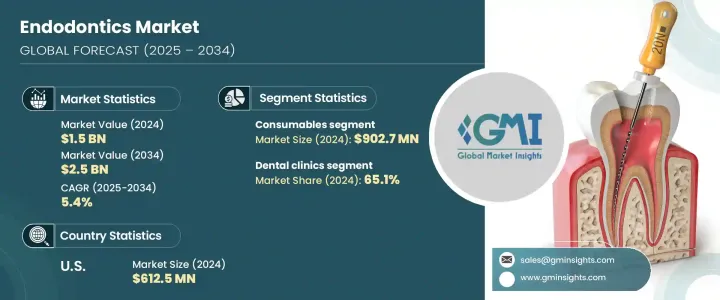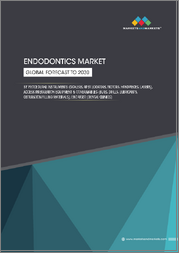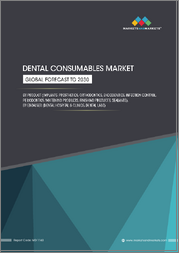
|
시장보고서
상품코드
1741040
치내 요법 시장 : 시장 기회, 성장 촉진요인, 산업 동향 분석 및 예측(2025-2034년)Endodontics Market Opportunity, Growth Drivers, Industry Trend Analysis, and Forecast 2025 - 2034 |
||||||
세계의 치내 요법 시장은 2024년에는 15억 달러로 평가되었고, CAGR 5.4%로 성장할 전망이며, 2034년에는 25억 달러에 이를 것으로 추정되고 있습니다.
이 시장의 기세는 주로 구강 건강에 대한 의식 증가, 노인 인구 증가, 치과 질환의 이환율 상승에 의해 초래됩니다. 발치보다 치아의 보존을 우선시하는 사람이 증가하고 있기 때문에 근관 치료의 수요가 크게 증가하고 있습니다. 천연치를 남기고 싶다고 하는 환자의 기호 변화와, 일반 치과 클리닉 및 전문 치과 클리닉의 증가가, 이 동향을 지지하고 있습니다.

수년간 치내 요법은 신기술의 도움으로 진화해 왔습니다. 3D 화상 시스템 등 진단 툴의 개량으로 근관 치료는 보다 정확하고 효율적인 것이 되었습니다. 동시에 처치에 사용되는 재료도 크게 진보했습니다. 생체 활성 재료 및 생체 적합성 재료의 개발로 합병증이 최소화되어 환자의 치료 성적이 전체적으로 향상되었습니다. 연구자들은 생체 시스템에 더 잘 맞는 재료 개발에 힘쓰고 있으며 임상의들이 밀봉성 향상, 항균 성능 향상, 재감염 감소를 달성할 수 있도록 돕고 있습니다. 또, 종래의 기계적 방법을 넘는 것을 목적으로 한, 기계 지원 시스템이나 재생 옵션 등의 기술 혁신에 의해, 처치는 보다 합리화되고 있습니다.
| 시장 범위 | |
|---|---|
| 시작 연도 | 2024년 |
| 예측 연도 | 2025-2034년 |
| 시작 금액 | 15억 달러 |
| 예측 금액 | 25억 달러 |
| CAGR | 5.4% |
2023년 시장 규모는 14억 5,000만 달러였습니다. 유형별로 소모품과 기구로 구분됩니다. 소모품은 2024년 총 매출액이 9억 270만 달러로 부문을 이끌었으며, 각 조치에 사용되는 아이템의 요구 증가를 부각시키고 있습니다. 소모품에는 파일 및 셰이퍼, 고정 재료, 용액 및 윤활제 등이 포함됩니다. 모터, 치근단 탐지기, 스케일러, 기계 어시스트 교합 시스템 등의 기구가 시장의 나머지 절반을 차지하고 있습니다. 소모품은 치내 요법의 다양한 단계에서 자주 사용되기 때문에 공급망의 중요한 일부가 되고 있습니다. 충치나 치수 감염과 같은 구강 위생 증례의 증가에 따라, 이러한 제품에 대한 수요는 계속 증가하고 있습니다.
치과 전문가는 특히 감염 관리를 위해 일회용 제품을 선호하며 사용합니다. 멸균된 가터퍼처, 일회용 주사기, 파일 등의 아이템은 환자의 안전성을 높이기 위해 치과에서 널리 채택되고 있습니다. 이로 인해 위생 기준이 개선되어 2차 오염의 위험이 줄어들고 치료가 보다 확실해졌습니다. 또한 소독제와 관개용액의 사용이 증가하고 있는 것이 각 근관 치료에 있어 보다 다양한 소모품에 대한 수요를 뒷받침하고 있습니다.
바이오 세라믹 기반의 실러와 같은 첨단 재료의 인기가 높아지고 있습니다. 이 옵션은 신체 시스템과의 호환성을 제공하고 항균성의 이점을 제공하기 때문입니다. 이러한 기술 혁신은 치료의 성공률을 높이고 치료의 워크플로우를 합리화하고 있습니다. 이러한 제품은 환자의 전체적인 체험을 향상시키는데 중요한 역할을 하고 있으며, 치내 요법에서 사용되는 소모품의 수요를 강화하고 있습니다.
최종 용도에 따라 시장은 치과 클리닉, 치과 병원 및 기타 환경으로 나뉩니다. 2024년 시장 점유율은 치과 진료소가 65.1%를 차지했으며, 1위로 2034년에는 16억 달러에 이를 것으로 예측되고 있습니다. 치과의원은 특히 근관 치료에 있어 이용하기 쉽고 비용대비 효과가 높은 서비스를 제공하기 때문에 환자 유입이 증가하고 있습니다. 천연 치아의 보존에 대한 의식의 고조나 충치의 증가로 인해, 환자는 발치나 전문 센터로의 통원을 선택하지 않고, 클리닉에서 시기적절한 치료를 받게 되어 있습니다.
일반 치과 클리닉과 전문 치과 클리닉의 확대도 수요 증가에 기여하고 있습니다. 이러한 클리닉은 환자의 다양한 요구, 특히 치내 요법 서비스를 관리하기 위한 설비가 갖추어져 있어 환자의 안정된 흐름을 유지하는 데 도움이 되고 있습니다. 또한, 일부 국가에서는 치과 보험이 적용되기 때문에 비용을 신경쓰지 않고 근관 치료를 선택하기 쉬워져 시장을 더욱 끌어올리고 있습니다.
2024년 세계 시장은 북미가 49.1%의 점유율을 차지했습니다. 미국에서만 6억 1,250만 달러의 매출을 기록하였고, 2034년까지 CAGR 5.6%로 성장할 것으로 예상되고 있습니다. 2023년, 미국의 치내 요법 시장은 5억 9,250만 달러가 되었습니다. 3D 영상이나 회전 파일 등의 진단 도구와 치료 기구의 혁신으로 환자에게 있어 치료가 보다 신속하고 쾌적해졌으며, 보다 많은 사람들이 치료를 받게 되었습니다.
치과 전문가를 위한 정기적인 교육 세션과 진료소에서의 디지털 툴과 AI 시스템의 채용 확대로 치료의 효율성이 대폭 향상되고 있습니다. 많은 일반 치과 의사가 근관 치료를 스스로 실시할 수 있게 됨으로써, 전문의에 대한 의존도가 낮아져 시장의 한층 더 성장에 박차를 가하고 있습니다. 시장 전체의 약 30%를 차지하는 대기업은 앞서가기 위해 연구개발에 많은 투자를 하고 있습니다. 동시에 중소기업이나 지역 기업은 지명도를 높이기 위해 2차적인 클리닉과 파트너십을 맺고 있습니다. 또한 비용 대비 효과가 높은 사업 모델로 인해 이들 기업은 질 높은 케어 솔루션을 제공하면서 경쟁력을 유지할 수 있습니다.
목차
제1장 조사 방법 및 범위
제2장 주요 요약
제3장 업계 인사이트
- 생태계 분석
- 업계에 미치는 영향요인
- 성장 촉진요인
- 치과 질환의 이환율 증가
- 치내 요법 기구의 기술적 진보
- 구강 위생에 대한 의식 고조 및 치과 관광 증가
- 업계의 잠재적 위험 및 과제
- 근관 치료에 따른 높은 위험
- 신흥 국가에서 숙련된 전문가의 부족
- 성장 촉진요인
- 성장 가능성 분석
- 기술적 상황
- 공급망 분석
- GAP 분석
- 규제 상황
- 미국
- 유럽
- 트럼프 정권의 관세에 대한 영향
- 무역에 미치는 영향
- 무역량의 혼란
- 보복 조치
- 업계에 미치는 영향
- 공급측의 영향(원재료)
- 주요 원재료의 가격 변동
- 공급망 재구성
- 생산 비용에 미치는 영향
- 수요측의 영향(판매가격)
- 최종 시장에 대한 가격 전달
- 시장 점유율 동향
- 소비자의 반응 패턴
- 공급측의 영향(원재료)
- 영향을 받는 주요 기업
- 전략적인 업계 대응
- 공급망 재구성
- 가격 설정 및 제품 전략
- 정책관여
- 전망 및 향후 검토 사항
- 무역에 미치는 영향
- Porter's Five Forces 분석
- PESTEL 분석
제4장 경쟁 구도
- 서문
- 기업 매트릭스 분석
- 기업의 시장 점유율 분석
- 주요 시장 기업의 경쟁 분석
- 경쟁 포지셔닝 매트릭스
- 전략 대시보드
제5장 시장 추계 및 예측 : 유형별(2021-2034년)
- 주요 동향
- 소모품
- 파일 및 셰이퍼
- 충전재
- 용액 및 윤활제
- 기타 소모품
- 기기
- 모터
- 정점 로케이터
- 스케일러
- 기계 보조에 의한 충전 시스템
- 기타 악기
제6장 시장 추계 및 예측 : 최종 용도별(2021-2034년)
- 주요 동향
- 치과 클리닉
- 치과 병원
- 기타 용도
제7장 시장 추계 및 예측 : 지역별(2021-2034년)
- 주요 동향
- 북미
- 미국
- 캐나다
- 유럽
- 독일
- 영국
- 프랑스
- 스페인
- 이탈리아
- 네덜란드
- 아시아태평양
- 중국
- 일본
- 인도
- 호주
- 한국
- 라틴아메리카
- 브라질
- 멕시코
- 아르헨티나
- 중동 및 아프리카
- 남아프리카
- 사우디아라비아
- 아랍에미리트(UAE)
제8장 기업 프로파일
- Brasseler USA
- COLTENE Group
- Dentsply Sirona
- DiaDent
- EdgeEndo
- Envista Holding
- Essential Dental Systems
- FKG Dentaire SA
- Ivoclar Vivadent
- Kerr Corporation
- MANI
- Septodent Holding
- Shenzhen Perfect Medical Instruments
- Ultradent Products
- VDW GmbH
The Global Endodontics Market was valued at USD 1.5 billion in 2024 and is estimated to grow at a CAGR of 5.4% to reach USD 2.5 billion by 2034. This market momentum is primarily driven by rising awareness of oral health, a growing elderly population, and a higher incidence of dental conditions. As more people prioritize dental preservation over extraction, the demand for root canal therapy has seen significant growth. The shift in patient preference toward keeping natural teeth, combined with the increase in general and specialized dental clinics, is supporting this trend.

Over the years, endodontic procedures have evolved with the help of new technologies. Improvements in diagnostic tools, such as 3D imaging systems, have made root canal treatments more accurate and efficient. At the same time, materials used in these procedures have also advanced significantly. The development of bioactive and biocompatible materials has minimized complications and improved overall patient outcomes. Researchers are working on materials that better align with biological systems, helping clinicians achieve improved sealing, antibacterial performance, and reduced reinfections. Procedures have also become more streamlined, thanks to innovations like machine-assisted systems and regenerative options that aim to go beyond traditional mechanical methods.
| Market Scope | |
|---|---|
| Start Year | 2024 |
| Forecast Year | 2025-2034 |
| Start Value | $1.5 Billion |
| Forecast Value | $2.5 Billion |
| CAGR | 5.4% |
In 2023, the market was valued at USD 1.45 billion. It is segmented by type into consumables and instruments. Consumables led the segment with a total revenue of USD 902.7 million in 2024, highlighting the growing need for items used in each procedure. These include files and shapers, obturation materials, solutions and lubricants, among others. Instruments such as motors, apex locators, scalers, and machine-assisted obturation systems make up the other half of the market. Consumables are frequently used across various stages of endodontic procedures, making them a crucial part of the supply chain. With rising oral health cases like cavities and pulp infections, the demand for these products continues to grow.
Dental professionals are also favoring single-use items, especially for infection control. Items like pre-sterilized gutta percha, disposable syringes, and files are being widely adopted by dental practices to enhance patient safety. This has led to better hygiene standards, reducing the risk of cross-contamination and making treatments more reliable. Additionally, the increasing use of disinfectants and irrigation solutions has supported the demand for more diverse consumables in each root canal treatment.
The popularity of advanced materials like bioceramic-based sealers is rising, as these options provide compatibility with the body's systems and offer antibacterial advantages. Such innovations have boosted the success rates of treatments and streamlined procedural workflows. These products play a key role in improving the overall patient experience, thereby reinforcing the demand for consumables used in endodontics.
Based on end use, the market is divided into dental clinics, dental hospitals, and other settings. Dental clinics took the lead in 2024, holding a 65.1% market share, and are forecasted to hit USD 1.6 billion by 2034. Clinics have seen growing patient inflow as they offer accessible and cost-effective services, particularly for root canal treatments. Increased awareness around preserving natural teeth and growing incidences of tooth decay have led patients to seek timely intervention at clinics instead of opting for extraction or visiting specialized centers.
The expansion of general and specialist dental clinics has also contributed to the rise in demand. These clinics are equipped to manage a wide variety of patient needs, especially endodontic services, which helps them maintain a steady flow of patients. Furthermore, the availability of dental insurance coverage in several countries has made it easier for people to choose root canal treatments without worrying about the cost, further boosting the market.
North America dominated the global market in 2024, accounting for a 49.1% share. The US alone recorded USD 612.5 million in revenue and is expected to grow at a CAGR of 5.6% through 2034. In 2023, the US endodontics market was valued at USD 592.5 million. Innovations in diagnostic tools and treatment instruments, such as 3D imaging and rotary files, have made procedures faster and more comfortable for patients, encouraging more individuals to seek treatment.
Regular training sessions for dental professionals and the growing adoption of digital tools and AI systems in practices are significantly advancing procedural efficiency. Many general dentists can now perform root canal procedures themselves, reducing dependency on specialists and fueling further market growth. Major players, which control around 30% of the total market, are investing heavily in R&D to stay ahead. At the same time, smaller and regional businesses are forming partnerships with secondary-tier clinics to gain visibility. Cost-effective operating models also allow these companies to stay competitive while offering quality care solutions.
Table of Contents
Chapter 1 Methodology & Scope
- 1.1 Market scope & definitions
- 1.2 Research design
- 1.2.1 Research approach
- 1.2.2 Data collection methods
- 1.3 Base estimates & calculations
- 1.3.1 Base year calculation
- 1.3.2 Key trends for market estimation
- 1.4 Forecast model
- 1.5 Primary research and validation
- 1.5.1 Primary sources
- 1.5.2 Data mining sources
Chapter 2 Executive Summary
- 2.1 Industry 3600 synopsis
Chapter 3 Industry Insights
- 3.1 Industry ecosystem analysis
- 3.2 Industry impact forces
- 3.2.1 Growth drivers
- 3.2.1.1 Increasing prevalence of dental diseases
- 3.2.1.2 Technological advancements in endodontic instruments
- 3.2.1.3 Rising awareness towards oral hygiene and growing dental tourism
- 3.2.2 Industry pitfalls & challenges
- 3.2.2.1 High risk associated with root canal treatment
- 3.2.2.2 Dearth of skilled professionals in developing countries
- 3.2.1 Growth drivers
- 3.3 Growth potential analysis
- 3.4 Technological landscape
- 3.5 Supply chain analysis
- 3.6 GAP analysis
- 3.7 Regulatory landscape
- 3.7.1 U.S.
- 3.7.2 Europe
- 3.8 Trump administration tariffs
- 3.8.1 Impact on trade
- 3.8.1.1 Trade volume disruptions
- 3.8.1.2 Retaliatory measures
- 3.8.2 Impact on the industry
- 3.8.2.1 Supply-side impact (raw materials)
- 3.8.2.1.1 Price volatility in key materials
- 3.8.2.1.2 Supply chain restructuring
- 3.8.2.1.3 Production cost implications
- 3.8.2.2 Demand-side impact (selling price)
- 3.8.2.2.1 Price transmission to end markets
- 3.8.2.2.2 Market share dynamics
- 3.8.2.2.3 Consumer response patterns
- 3.8.2.1 Supply-side impact (raw materials)
- 3.8.3 Key companies impacted
- 3.8.4 Strategic industry responses
- 3.8.4.1 Supply chain reconfiguration
- 3.8.4.2 Pricing and product strategies
- 3.8.4.3 Policy engagement
- 3.8.5 Outlook and future considerations
- 3.8.1 Impact on trade
- 3.9 Porter's analysis
- 3.10 PESTEL analysis
Chapter 4 Competitive Landscape, 2024
- 4.1 Introduction
- 4.2 Company matrix analysis
- 4.3 Company market share analysis
- 4.4 Competitive analysis of major market players
- 4.5 Competitive positioning matrix
- 4.6 Strategy dashboard
Chapter 5 Market Estimates and Forecast, By Type, 2021 - 2034 ($ Mn)
- 5.1 Key trends
- 5.2 Consumables
- 5.2.1 Files and shapers
- 5.2.2 Obturation materials
- 5.2.3 Solutions and lubricants
- 5.2.4 Other consumables
- 5.3 Instruments
- 5.3.1 Motors
- 5.3.2 Apex locators
- 5.3.3 Scalers
- 5.3.4 Machine assisted obturation systems
- 5.3.5 Other instruments
Chapter 6 Market Estimates and Forecast, By End Use, 2021 - 2034 ($ Mn)
- 6.1 Key trends
- 6.2 Dental clinics
- 6.3 Dental hospitals
- 6.4 Other end use
Chapter 7 Market Estimates and Forecast, By Region, 2021 - 2034 ($ Mn)
- 7.1 Key trends
- 7.2 North America
- 7.2.1 U.S.
- 7.2.2 Canada
- 7.3 Europe
- 7.3.1 Germany
- 7.3.2 UK
- 7.3.3 France
- 7.3.4 Spain
- 7.3.5 Italy
- 7.3.6 Netherlands
- 7.4 Asia Pacific
- 7.4.1 China
- 7.4.2 Japan
- 7.4.3 India
- 7.4.4 Australia
- 7.4.5 South Korea
- 7.5 Latin America
- 7.5.1 Brazil
- 7.5.2 Mexico
- 7.5.3 Argentina
- 7.6 Middle East and Africa
- 7.6.1 South Africa
- 7.6.2 Saudi Arabia
- 7.6.3 UAE
Chapter 8 Company Profiles
- 8.1 Brasseler USA
- 8.2 COLTENE Group
- 8.3 Dentsply Sirona
- 8.4 DiaDent
- 8.5 EdgeEndo
- 8.6 Envista Holding
- 8.7 Essential Dental Systems
- 8.8 FKG Dentaire SA
- 8.9 Ivoclar Vivadent
- 8.10 Kerr Corporation
- 8.11 MANI
- 8.12 Septodent Holding
- 8.13 Shenzhen Perfect Medical Instruments
- 8.14 Ultradent Products
- 8.15 VDW GmbH



















